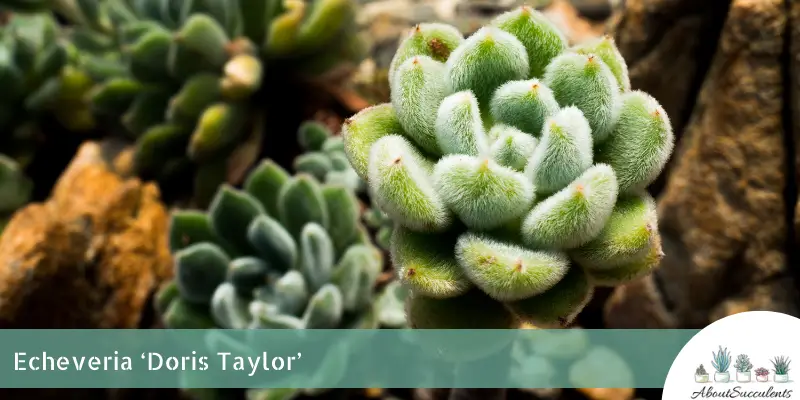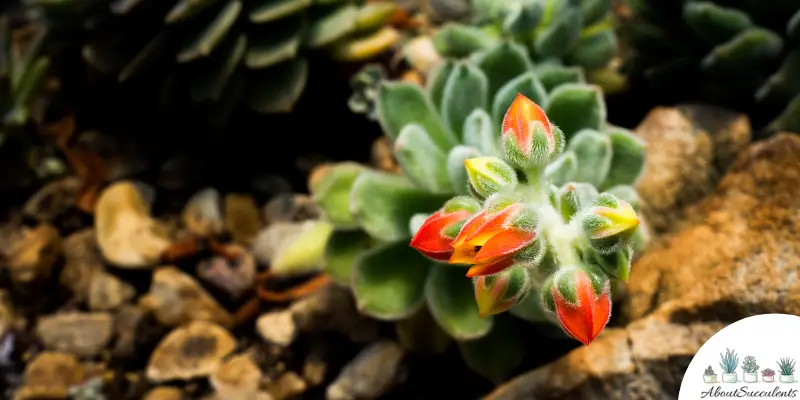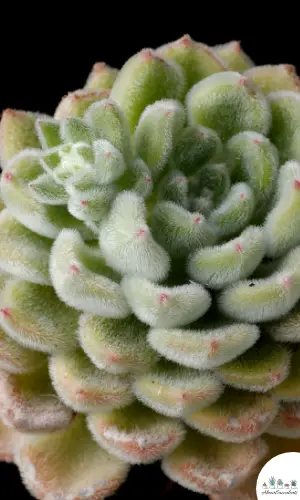
Echeveria “Doris Taylor” is a delightful succulent with its fleshy leaves that are adorned by shiny silver hairs. This succulent was created by Dr. W. Taylor who produced a hybrid out of Echeveria pulvinata and Echeveria selosa. He must have been truly proud of his work as he named it after his wife.
The charming plant that also goes by the alias, “Woolly Rose” is categorized as a petite succulent that can grow to a height of 13cm (5”) tall and up to 20cm (8”) wide.
The pale green-colored leaves have a length of 7.62cm (3”) and 2.54cm (1”) wide. If the plant is frequently exposed to bright light, the tips of its leaves can turn into a light-red color.
In the spring or fall seasons, Doris Taylor will produce small yellow flowers that are accented with red colors.
Owing to the origin of its parents, Woolly Rose can be considered native to Mexico and belongs to the Crassulaceae family.
General Information:
Also known as: Doris Taylor, Woolly Rose Plant
Plant Family: Crassulaceae
Origin: Hybrid between Echeveria pulvinata and Echeveria setosa both of which are native to Mexico.
Height: 13cm (5”)
Exposure: 6 hours of full to partial sun.
Water Needs: Allow the soil to dry out completely before giving it a thorough soaking.
Soil Type: Standard potting or cactus mix with the addition of pumice, perlite, and gravel to improve drainage.
Soil pH: 5.5 to 6.0
How to Grow and Care for Echeveria “Doris Taylor”

Echeveria Doris Taylor is a succulent plant that is easy – and fun – to grow and care for. Its beauty and elegance are 2 good reasons why Woolly Rose is a popular choice of succulent for weddings and as an adornment to wreathes.
Sunlight
Doris Taylor can also be part of your outdoor garden. The important thing to keep in mind is to plant Woolly Rose in an area that gets 6 hours or partial or full morning sunlight every day.
If the temperature in your region becomes cold and goes below -6.7° C (20° F), plant Echeveria Doris Taylor in a pot that you can move indoors. Place Doris Taylor near a window that receives 4 to 6 hours of sunlight per day.
You can also put Woolly Rose under a Grow Light if you decide to keep the plant indoors.
Watering

Echeveria Doris Taylor’s origin is rooted in the hot and humid climate of Mexico. Similar to other succulent plants, it can go without water for quite some time. Giving Woolly Rose water before the soil has dried out will do more harm than good.
If you water the soil while it still retains moisture, you’ll increase the risk of the roots rotting. Always check the moisture level of the soil before deciding to water.
The simple way to do this is to insert a stick an inch deep into the soil. Pull out the stick and assess its dryness. If you’re confident that the soil is stone dry, then give it a thorough soaking.
At the same time, Echeveria Doris Taylor cannot survive long periods without water. You’ll have to check the soil frequently to make sure Woolly Rose receives water when it has to.
A simple rule to keep in mind is to water more frequently in the summertime and less during the winter.
Another factor to consider is the humidity level. If the weather is more humid, the soil will retain moisture longer and will need less water.
Pot and Soil
If you prefer to house Echeveria Doris Taylor in a pot, choose one that’s made of either ceramic and terracotta.
We mentioned the importance of drying out the soil before watering. These materials support evaporation and will allow excess moisture to leave the soil.
The pot must have a drain hole with a mesh net cover. You’ll know that you’ve given the soil a good soaking if excess water comes out through the drain hole. The mesh net is there to prevent soil from falling out.
Woolly Rose prefers well-draining soil that has airflow. Standard succulent potting mix or cactus soil are good choices for soil. Just add ingredients such as gravel, pumice, and perlite to improve drainage.
How to Propagate Echeveria “Doris Taylor”
It’s easy to add to your collection of Woolly Rose. You have 2 methods for propagating this beautiful succulent – Stem Cuttings and Beheadings.
Method 1: Stem Cuttings
Step 1: Cut a stem from the main plant by using a sharpened and sterilized pair of garden scissors.
Step 2: Allow the stem cuttings to harden with calluses for 2 to 3 days.
Step 3: Once the stem has enough hardened calluses, place it on top of well-draining soil.
Step 4: Lightly mist the soil until the cuttings have successfully taken root.
Step 5: If the roots have firmed up, water the soil only when it’s 100% dry.
Method 2: Beheadings
Step 1: Remove the head of Doris Taylor with the use of a sharpened and sterilized pair of garden shears. Make sure to leave a few inches of the head connected to the stem of the main plant.
Step 2: Let the head dry out completely and grow hard calluses. This process might take 3 days.
Step 3: Plant the head in well-draining soil when it has developed enough calluses.
Step 4: Water the soil only when it has gone completely dry.
Frequently Asked Questions
Is Echeveria “Doris Taylor” Toxic to Cats and Dogs?
Echeveria Doris Taylor does not appear on the American Society for the Prevention of Cruelty to Animals (ASPCA). website’s list of plants that are toxic to cats and dogs.
Why Is My Echeveria “Doris Taylor” Dying?
Echeveria Doris Taylor is a resilient succulent but it’s not invulnerable to the deadly consequences of overwatering and the dangers of having pests reside in your plant.
Overwatering
Overwatering will lead to root rot. If the roots start to rot, fungal infection will take place. Unless the infection is stopped, Woolly Rose will die.
When you’re attending to Doris Taylor, look for discoloration on its green leaves and stems. If you notice a blackish-yellow discoloration, don’t take any chances and act right away.
First, cut off the infected parts with a sterilized knife or garden shears. Next, uproot the plant from the soil. Shake off the excess soil and examine the roots carefully. Cut off the rotten roots and allow the plant to dry off.
Finally, replant Woolly Rose in a pot filled with fresh cactus soil mix. Your beloved succulent plant will have a second chance in life!
Pest Infestation
When you have a beautiful succulent as Doris Taylor, expect pests such as mealybugs, scale insects, spider mites, and aphids to not be far behind.
These pests present a danger because they’ll drink away Woolly Rose’s sap which contains much-needed nutrients.
Spraying the plant with neem oil will be effective in keeping pests away. If you see white, cotton-like substances on the leaves, this is the handiwork of mealybugs and spider mites.
You can remove the substances with a cotton ball soaked in 70% isopropyl alcohol.
Does Echeveria “Doris Taylor” Produce Flowers?
Yes, Echeveria Doris Taylor produces small yellow flowers with accents of red colors in the spring or fall seasons.
Last Updated on June 9, 2022 by Sofia Lara